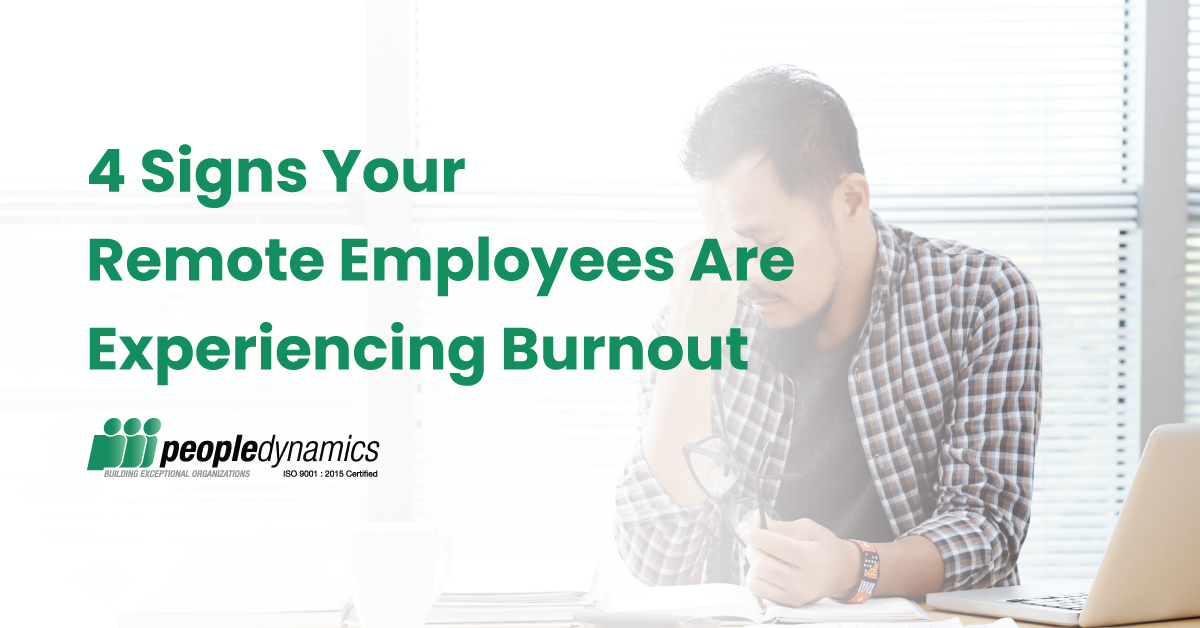With the strict need for less mobilization, while the pandemic is ongoing, remote working is one of the best solutions for your employees. And this doesn’t just comply with government directives but also brings various benefits to your organization. Studies have found various advantages of providing employees with remote working arrangements such as increased productivity, job satisfaction, and employee morale. Remote employees also benefit from this arrangement since they save on transportation resources and fees, time, and even lunches. But, just because they’re enjoying the pros of working from home doesn’t mean that they’re safe from work-related stress. Your remote employees may be showing signs of one of them: burnout.
What is employee burnout?
Burnout, or burn-out, is a syndrome recognized by the World Health Organization (WHO). In their International Statistical Classification of Diseases and Related Health Problems (ICD), the WHO defines burnout as “a syndrome conceptualized as resulting from chronic workplace stress that has not been successfully managed. It is characterized by three dimensions: 1) feelings of energy depletion or exhaustion; 2) increased mental distance from one’s job, or feelings of negativism or cynicism related to one’s job; and 3) reduced professional efficacy. Burn-out refers specifically to phenomena in the occupational context and should not be applied to describe experiences in other areas of life.”
This means that burnout is a real medical condition that may affect your employees’ performance. No one is immune to burnout. Even your most engaged employees can experience it. In fact, according to a 2019 Gallup Study, 28% of full-time employees feel burned out at work “very often” or “always.” Another 48% feel burned out “sometimes”.
What are the signs your remote employees are experiencing burnout?
Now that you know what is employee burnout, how do you know that your remote employees are experiencing it? Given that you aren’t in the same location as them. Here are the signs you need to watch out for!
Your remote employees have a hard time finishing tasks
An unfinished task isn’t anything uncommon. After all, different factors may affect an employee’s ability to finish their task. However, if it happens too frequently to a remote employee that it starts affecting your organization, you may need to investigate it.
Burned-out remote employees have a hard time finishing tasks. They feel exhausted most of the time and have a hard time focusing. They have no energy to do their work which can lead to procrastination.
How to fix it: There are different causes why your remote employees may have a hard time finishing tasks. One of them is an unmanageable workload. According to Gallup’s Employee Burnout: Causes and Cures report, an unmanageable workload is one of the top causes of burnout. They report that employees who strongly agree that they always have too much to do are 2.2 times more likely to say they experience burnout very often or always at work.
So, check your employees regularly to determine if they have too much workload. Ask them about the things that they do and put those on a list. Among those, have them note which tasks take longer to do than what they like and the reasons why it does. Is it because of the work process? Do they need something from another person and that person takes too long to give it? Or is it because of unrealistic deadlines? This is also a good time to ask them for improvement suggestions on work processes to make their work easier.
They may also be shouldering tasks that are not under their responsibilities. If that’s the case, you need to investigate why they’re doing those and if that can be delegated to another person.
Their quality of work drops
Have you experienced having a stellar employee suddenly submit work with a lower quality than usual? What about this: a team’s output is different than what you expect based on past performance?
If you notice these signs, then employee burnout may be the cause. Burnout causes employees to disengage from their work resulting in decreased productivity. Remember that in WHO’s definition, one of the dimensions that characterize burnout is reduced professional efficacy.
How to fix it: The first step to alleviate this sign is to talk to the employee. This is why your company’s internal communication is important. Your remote employees should trust you enough to disclose the reasons why they’re having a hard time with their work. And depending on what your employee shared with you, you could start your interventions.
Your remote employees are on leave or sick frequently
It’s a fact that health affects work and work affects health. So, if your remote employee is often sick, that might be a sign that they’re experiencing burnout. Burnout is a result of chronic workplace stress that’s not successfully managed. And, according to WebMD, some physical symptoms due to stress that your burned-out remote employee may experience are:
- Headaches
- Stomach problems such as stomach cramps, diarrhea, constipation, and nausea
- Aches, pains, and tense muscles
- Chest pain and rapid heartbeat
- Frequent colds and infections
- Insomnia or hypersomnia
These are just the physical symptoms. Your burned-out remote employee may also experience emotional and mental distress.
How to fix it: It’s always good to keep your employees healthy, especially in times of crisis. You could do informal checkups on how they feel through calls or video conferences. Or, approach this problem holistically, such as investing in wellness programs in that they can participate. You could also offer insurance as an employee benefit, to give them security and protection in case they experience problems that insurance can cover.
They’re often irritable or hostile
Remember that burnout doesn’t only have physical manifestations, but also mental and emotional ones. Burnout often causes your remote employees to be easily irritable or frequently hostile. And this can transform your remote employee from a good to a bad one.
How to fix it: Remote employees who’re often irritable and hostile can be hard to work with and may cause delays in your projects. And since they’re working remotely, it’s easier for them to disconnect.
To solve this, you have to focus on positivity. Acknowledge your remote employee for a job well done. There are creative ways to do this that don’t incur expenses for your company. Showing your appreciation can help them be more engaged, lessening the effects of burnout on their emotional stability. You could also invite them to attend learning and development programs about emotional intelligence so that they could learn how to better manage their emotions.
Now you know the signs to watch out for to know if your remote employees are experiencing burnout. Still, remember: prevention is always better than cure. Learn how to prevent employee burnout so that you can lessen the risks that these signs appear!




